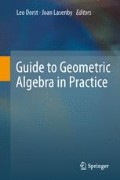Abstract
This paper describes a novel iterative Inverse Kinematics (IK) solver, FABRIK, that is implemented using Conformal Geometric Algebra (CGA). FABRIK uses a forward and backward iterative approach, finding each joint position via locating a point on a line. We use the IK of a human hand as an example of implementation where a constrained version of FABRIK was employed for pose tracking. The hand is modelled using CGA, taking advantage of CGA’s compact and geometrically intuitive framework and that basic entities in CGA, such as spheres, lines, planes and circles, are simply represented by algebraic objects. This approach can be used in a wide range of computer animation applications and is not limited to the specific problem discussed here. The proposed hand pose tracker is real-time implementable and exploits the advantages of CGA for applications in computer vision, graphics and robotics.
Access this chapter
Tax calculation will be finalised at checkout
Purchases are for personal use only
Notes
- 1.
Editorial note: Note here that in this chapter CGA equations are given in terms of n ∞ and \(\bar{n}\), where \(\bar{n}= -2 n_{o}\).
- 2.
Editorial note: This is essentially (4.2) for n=3.
References
Hestens, D., Sobczyk, G.: Clifford Algebra to Geometric Calculus: A Unified Language for Mathematics and Physics. Reidel, Dordrecht (1984)
Doran, C., Lasenby, A.: Geometric Algebra for Physicists. Cambridge University Press, Cambridge (2003)
Aristidou, A., Lasenby, J.: Inverse kinematics: a review of existing techniques and introduction of a new fast iterative solver. Cambridge University Department of Engineering Technical Report, CUED/F-INFENG/TR-632 (2009)
Dorst, L., Fontijne, D., Mann, S.: Geometric Algebra for Computer Science: An Object-Oriented Approach to Geometry. Morgan Kaufmann, San Mateo (2009)
Bayro-Corrochano, E., Kähler, D.: Motor algebra approach for computing the kinematics of robot manipulators. J. Robot. Syst. 17(9), 495–516 (2000)
Bayro-Corrochano, E.: Robot perception and action using conformal geometric algebra. In: Handbook of Geometric Computing, pp. 405–458, Chap. 13. Springer, Berlin (2005)
Zamora, J., Bayro-Corrochano, E.: Inverse kinematics, fixation and grasping using conformal geometric algebra. In: Proceedings of the IEEE International Conference on Intelligent Robots and Systems (IROS ’04), vol. 4, pp. 3841–3846 (2004). doi:10.1109/IROS.2004.1390013
Hildenbrand, D.: Tutorial: Geometric computing in computer graphics using conformal geometric algebra. Comput. Graph. 29(5), 795–803 (2005)
Zamora, J., Bayro-Corrochano, E.: Kinematics and grasping using conformal geometric algebra. In: Lenarčič, J., Roth, B. (eds.) Advances in Robot Kinematics, pp. 473–480. Springer, Berlin (2006)
Hildenbrand, D., Zamora, J., Bayro-Corrochano, E.: Inverse kinematics computation in computer graphics and robotics using conformal geometric algebra. Adv. Appl. Clifford Algebras 18, 699–713 (2008)
Hildenbrand, D., Fontijne, D., Wang, Y., Alexa, M., Dorst, L.: Competitive runtime performance for inverse kinematics algorithms using conformal geometric algebra. In: Proceedings of Eurographics Conference, 2006
Tanev, T.K.: Geometric algebra approach to singularity of parallel manipulators with limited mobility. In Lenarcic, J., Wenger, P. (eds.) Advances in Robot Kinematics: Analysis and Design, pp. 39–48. Springer, Dordrecht (2008)
Bayro-Corrochano, E., Zamora, J.: Differential and inverse kinematics of robot devices using conformal geometric algebra. Robotica 25(1), 43–61 (2007)
Hildenbrand, D., Lange, H., Stock, F., Koch, A.: Efficient inverse kinematics algorithm based on conformal geometric algebra (using reconfigurable hardware). In: Proceedings of the 3rd International Conference on Computer Graphics Theory and Applications, Madeira, Portugal, 2008
Wang, L.-C.T., Chen, C.C.: A combined optimization method for solving the inverse kinematics problems of mechanical manipulators. IEEE Trans. Robot. Autom. 7(4), 489–499 (1991)
Aristidou, A., Lasenby, J.: FABRIK: a fast, iterative solver for the inverse kinematics problem. Graph. Models 73(5), 243–260 (2011)
PhaseSpace Inc: Optical motion capture systems. http://www.phasespace.com
Lasenby, A.N., Lasenby, J., Wareham, R.: A covariant approach to geometry using geometric algebra. Cambridge University Department of Engineering Technical Report, CUED/F-INFENG/TR-483 (2004)
Lasenby, J., Fitzgerald, W.J., Lasenby, A.N., Doran, C.J.L.: New geometric methods for computer vision: an application to structure and motion estimation. Int. J. Comput. Vis. 26(3), 191–213 (1998)
Aristidou, A.: Tracking and modelling motion for biomechanical analysis. PhD Thesis, University of Cambridge, Cambridge, UK (October 2010)
Kaimakis, P., Lasenby, J.: Physiological modelling for improved reliability in silhouette-driven gradient-based hand tracking. In: Proceedings of the International Conference on Computer Vision and Pattern Recognition, Miami, USA, 25 June 2009, pp. 19–26
The Mathworks—MATLAB and Simulink for technical computing. http://www.mathworks.com
Author information
Authors and Affiliations
Corresponding author
Editor information
Editors and Affiliations
Rights and permissions
Copyright information
© 2011 Springer-Verlag London Limited
About this chapter
Cite this chapter
Aristidou, A., Lasenby, J. (2011). Inverse Kinematics Solutions Using Conformal Geometric Algebra. In: Dorst, L., Lasenby, J. (eds) Guide to Geometric Algebra in Practice. Springer, London. https://doi.org/10.1007/978-0-85729-811-9_3
Download citation
DOI: https://doi.org/10.1007/978-0-85729-811-9_3
Publisher Name: Springer, London
Print ISBN: 978-0-85729-810-2
Online ISBN: 978-0-85729-811-9
eBook Packages: Computer ScienceComputer Science (R0)

